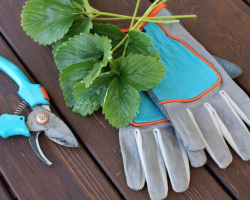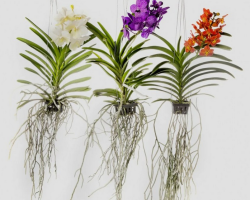Why is the correct acidity of the soil so important? How to measure the acid-base balance of the soil: devices and folk methods. What natural conditions pH depend on and how to adjust it in the right direction?
Content
- How to determine the acidity of the soil pH yourself?
- How to determine the acidity of soil pH at home?
- Video: How to determine the acidity of the soil of currant leaves instead of litmus?
- How to collect the Earth to determine the acidity of the soil?
- How to mix soil and water to determine the acidity of the soil?
- What acidity of the soil is suitable for different types of plants: table
- What is the acidity of the soil in different areas?
- How to change the acidity of the soil?
- Video: Fertilizer of plants ash
In this article we will tell:
- How to determine the acidity of PH soil yourself at home?
- What should be the acidity of the soil for plants - the table from our article contains a lot of vegetables, herbs, berries and fruits.
- How to change the acidity of the soil if it does not suit you?
How to determine the acidity of the soil pH yourself?
Soil acidity is important for those who want to grow "Capricious" plants. For example, the acidity of the soil for blue should be 4 on the PH scale, and this is a very acidic soil, which will have to be created artificially. For many traditional plants, pH within the boundaries of 6.0 to 7.5 units is suitable. How to determine the acidity of the soil?
The soil acidity meter will be very useful for those who have in the garden or in vases with indoor flowers for some reason, everything is growing poorly. And also determine the acidity of the soil before buying a house, because changing the acid-base balance in the ground is an accomplished, but also requireing a task.
It is most reliable to buy a special device - soil acidity will be shown on its scale, quite accurately. Such devices made in China are relatively affordable. For example, such as in the next photo, now costs about 500 rubles. There are more expensive and high -quality soil composition analyzers. In general, the best option is to attribute the soil sample to the laboratory, where you will be signed not only in the acidity of the soil, but also of what kind of mineral substances there are many or not enough in it.

Another rather reliable way to determine the acidity of the soil is to buy litmus paper.
Be careful when buying, there is litmus paper, which shows the difference only in 1 unit pH. It is usually a lot, at a low price of packaging. But tenths are important for zealous gardeners, that is, more accurate PH indicators are needed.
In the next photo, you can notice that this litmus paper not only does not allow you to determine the tenth pH, \u200b\u200band the color difference between indicators of 5 and 7 is not very distinguishable for the eye. That is, it allows you to get some data, but not very accurate.

There is a highly sensitive litmus paper. Its minus is only in price, at a price it is comparable to an inexpensive electronic device to determine the acidity of the soil. Lakmus test paper can be found not only in online stores, but also in pharmacies. In pharmacies There is a lakmus that can accurately show pH. In the next photo, this is on the right, she has an exact scale, but in the package there is only one thing. When buying specific packaging, pay attention to the accuracy of the scale. Pharmacy test strips are used to determine the acidity of urine, determine gynecological diseases, and to analyze the acidity of saliva. But no one prohibits the use of them to determine the acidity of the soil.

How to determine the acidity of soil pH at home?
Here we have collected tips on how to determine the acidity of the soil at home with the help of the most improvised means. We will tell you how to use currant sheets for this and what the beets can tell about. These methods give an approximate result.
- Checking the acidity of the soil with currant leaves:
Collect green currant leaves, without yellowness. Torn them with your hands in small pieces and lay them in a transparent dish of glass or plastic. Then pour the leaves with boiling water and mix them. Wait for the leaves to brew a little, and the water acquired a greenish tint. Then pour a full tablespoon of soil from the site into the glass. Stir the ground thoroughly and leave it to settle it. When the earth sets down, we evaluate the acidity of the soil.
- Violet, pink or lilac shade will tell you that the soil is acidic and it is advisable to deoxid it.
- If the water is simply muddy, without a pink shade, then this means that the soil is neutral or alkaline.
Video: How to determine the acidity of the soil of currant leaves instead of litmus?
- How to determine the acidity of the soil by color of beet leaves?
Beetroot leaves react violently to a change in soil acidity. Beetroot loves neutral pH, that is, about 7 units.
- The leaves of beets are green and red on them only veins, if the acidity of the soil is neutral or a slightly alkaline environment.
- If the soil is slightly acidic, then small red stains appear on the tops of the beets.
- If the tops are red, then this means that you overdo it with fertilizers that increase acidity, and the garden must be deoxidized with ash, or in autumn chalk and lime.
How to collect the Earth to determine the acidity of the soil?
To determine the acidity of the soil, samples must be taken from a depth of 10-15 cm. That is, at the level where the roots of your plants are located. If you want to create the perfect microclimate for radishes, then you need to take the Earth very deeply. If you are interested in raspberries, then it also has a surface root system at a level of 10-30 cm. But in currants, the bulk of the roots is located at a level of 25-40 cm.

Take it right away a few soil samples from different sides of the site. So your study will be more precise. Or if you use an electronic soil acidity meter, stick it into the ground in several places.
How to mix soil and water to determine the acidity of the soil?
The measurement of soil acidity should be carried out by a device on well -moistened soil. If you use Lakmus, then you also can not do without water. And here such a nuance is important that the acidity of the acidity of your water itself can affect.
It is advisable to first measure the acidity of the water itself. It should be in the range from 5.6 to 6.0.
If your pH level is not like that, then use soda and vinegar to correct it. After you are convinced of the correct acidity of the water, take 2.5 parts of the liquid and 1 part of the Earth, mix them.
Even tap water according to the norms of SanPiN can be with very different acidity, from 6.5 to 9 pH. In the wells, water can be in general. In very small wells, the water is "soft" rain. But usually the water in the wells is alkaline, And in some areas very alkaline. Clay is guilty, which has a pH at the level of 9-10 units.

What acidity of the soil is suitable for different types of plants: table
Different crops have their favorite level of acidity. These tables indicate a range of acidity, with the upper and lower boundary. If the pH is within these values, then the plant feels normally. And to determine the ideal acidity for this culture, add the upper and lower limit of acidity, and then divide this number by two.
For example, cucumbers grow normally with acidity from 5 to 7.5. We compose these numbers, divide by 2, and we get that the best acidity for cucumbers is 6.25.
Acidity of soil table of vegetables, herbs and some fruits:

You may notice that slightly acidic and neutral soils, with an acidity of 6.5 or 7, like most plants. But here potatoes like a little acidified soils more. The favorite acidity of the soil for potatoes is in the range from 4.5 to 6 pH, the arithmetic mean between these numbers 5.25 pH. Poested soil is also loved by melons. There are areas, for example, the Poltava region in Ukraine, where potatoes and melting are growing well. But tomatoes and cucumbers there grow worse than in other regions. This is due to the special composition and acidity of the soil.

Interestingly, some plants themselves change the acidity of the soil. For example, coniferous trees create a soil with low acidity in their foot. And these trees themselves need this basis. If you are planting a small fir, then it is difficult to grow it at first, the seedlings often dry out. But if you bring to its roots the bell needles of other conifers, then the tree will become easier.
If you want to plant a indoor plant, and you know that it needs acidic soil, then the earth, taken near the spruce or pine. If mushrooms grow on it, lichens and nothing else grows, then this is a sure sign that the soil is really sour.
Store soils, which indicate a certain acidity, in our opinion, need to be trusted with caution. When checking by devices, they often have ordinary neutral acidity, and not the same as indicated on the pack.

What is the acidity of the soil in different areas?
- The soil acidity in some areas is its own special acidity. For example, where there is underground limestone, The soil will be alkaline. And if you know that somewhere near the site they get lime, then this site will surely need mineral fertilizers to increase acidity all the time.
- Another substance that makes the soil alkaline - magnesium. The vicinity of the city of Selidovo, Donetsk region, contains a lot of magnesium in rocks. In these places there is very bitter water in wells, so bitter that it is impossible to drink. The river, which flows around the district, was called salty. But the water in it is not so much salty as bitter. Although, in fact, the name is correct, it is made by such salts of magnesium and other alkaline earth metals: magnesium, potassium and calcium.
- But if there are careers in your area where they get sandstone or clay, For pottery production, the acidity of the soil will most likely be neutral by nature.
How to change the acidity of the soil?
If the acidity of the soil needs to be increased, then fertilizers will help to cope with this task. The soil makes a little effort very efficiently manure. Perfectly raise acidity and mineral fertilizers: ordinary nitrofosk and nitroammofosk. Pure nitroammophosics usually acute 8.8 pH. If you want to use some combined fertilizer, pay attention to the manufacturer’s information on the package. Liquid green fertilizers made of weeds, urea, bird droppings and compost - all this also increases the acidity of the soil.
If your soil is on the contrary too high acidity, then you can use chalk, lime and dolomite flour. All of the listed funds are introduced to the ground in the fall. Because if you do it at another time, then it will harm plants. Still, a change in acidity with lime is a rather rude intervention in their habitat.
The beloved method of reducing acidity is the use of ash. Ash - This is pure alkali, in addition, it is natural and often free material. If you want to know more about how to fertilize the garden with ash, watch the next video.
On our site there are many other interesting articles about gardening and fertilizers:
- How to make green fertilizer from grass?
- How to feed cucumbers for a good harvest?
- How to grow tomato seedlings?
- AVA fertilizer: advice on use.
- Siderates plants to improve the composition of the soil.
- Do -it -yourself compost: special composite, compost pits and liquid compost of weeds.







